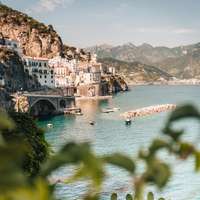
A Gladiator fan’s guide to Europe
By Issy Von Simson
November 2024
Gladiator II is transporting us back to the ancient world—and might just inspire you to see its incredible sites for yourself. Bookmark these hotspots to plan a history-packed itinerary
If Russell Crowe inspired a thousand trips to the filming locations of Gladiator back in 2000, Paul Mescal is about to sell the ancient world to a new generation in the long-awaited sequel. And the fascination is no wonder: Standing in the middle of the Colosseum in modern-day Rome brings the drama of what took place there 2,000 years ago to life. The roar of wild animals; the bloody executions; the unbridled battles.
It’s Malta, though, that was the stand-in filming location for Rome in both Gladiator and Gladiator II, out on November 22 in the U.S. And indeed, ancient Greek and Roman influence can be found all over Europe, meaning that while no history fan’s trip is complete without a stop at one of the big-hitting sites—the Acropolis of Athens, Delphi’s ruins, the Roman Forum, Pompeii and Herculaneum (scroll to the end for our map)—there is much to see beyond those well-trodden paths. Here are some of our favorites.

Flights, camera, action: Set-jetting in Italy
From Roman Holiday to Ripley, these are the best filming locations to visit in Italy
A Roman outpost in Malta
Domus Romana, Mdina, Malta

Malta’s historic capital, Valletta, is near to the filming location of Gladiator II

A replica Colosseum was constructed in the village of Kalkara. Photo, and top, both courtesy of Paramount Pictures
While many of Gladiator II’s scenes were filmed in a huge replica Colosseum built in Kalkara, near Malta’s capital, Valletta—see our gallery of filming locations, below—the country also has plenty of real-deal Roman sites. Not least the Domus Romana (“Roman house”), believed to date from the first century B.C.E. but discovered in the late 19th century, quite by accident, when a landscaper going about his day’s digging struck a floor of amazingly intact mosaics. The Maltese had the foresight to quickly build a museum around the archaeological site.
Further excavation revealed that this had been home to an aristocratic family with an eye for the finer things in life, unearthing treasures such as extensive collections of coins, jewelry, delicate glass perfume bottles, and richly decorated pottery. There was also a full-size statue of Britain-invading Emperor Claudius, who many historians concur was murdered by his own wife with poisonous mushrooms.

Denzel Washington, who plays arms dealer Macrinus, has described Gladiator II as “the biggest film I’ve been on”

L-R: Pedro Pascal, director Ridley Scott, and Paul Mescal share a joke while filming Gladiator II in Malta. All gallery images: courtesy of Paramount Pictures

The purpose-built Colosseum set, a filming location near Fort Rinella in Kalkara, Malta, is seen here flooded for a dramatic battle recreation

Other Gladiator II arena scenes were filmed on sets constructed in Ouarzazate, Morocco, where the original film was also shot

To film the rhino scenes, the production crew constructed a frame covered in artificial skin, mounted on a hydraulic vehicle

Pedro Pascal, seen here in front of the vast sets constructed in Ouarzazate, Morocco, plays Roman general Marcus Acacius

Denzel Washington, who plays arms dealer Macrinus, has described Gladiator II as “the biggest film I’ve been on”

L-R: Pedro Pascal, director Ridley Scott, and Paul Mescal share a joke while filming Gladiator II in Malta. All gallery images: courtesy of Paramount Pictures

The purpose-built Colosseum set, a filming location near Fort Rinella in Kalkara, Malta, is seen here flooded for a dramatic battle recreation

Other Gladiator II arena scenes were filmed on sets constructed in Ouarzazate, Morocco, where the original film was also shot

To film the rhino scenes, the production crew constructed a frame covered in artificial skin, mounted on a hydraulic vehicle

Pedro Pascal, seen here in front of the vast sets constructed in Ouarzazate, Morocco, plays Roman general Marcus Acacius

Denzel Washington, who plays arms dealer Macrinus, has described Gladiator II as “the biggest film I’ve been on”












Ancient Greek ruins in Sicily
Valley of the Temples, Agrigento, Italy

Step back in time at the Temple of Hera

A modern touch: Icarus’ bronze, fallen form was introduced in 2011
After 2,500 years of fires, earthquakes and ransacking by the Carthaginians, the ruined city of Akragas (in present-day Agrigento) is still in remarkable shape. Known as the Valley of the Temples, on the southwestern coast of Sicily, the site is the island’s most comprehensive example of Greek rule. Of the eight monumental temples built as a show of power and dedicated to deities and divine heroes including Zeus, Hera and Heracles, some have fared better than others.
Make a beeline for the Temple of Concordia, one of the best-preserved Doric temples in the world, attributed to the goddess of harmony by archaeologists after a Roman-era Latin inscription was uncovered nearby. Those in the know come in spring, when the valley is full of flowering almond trees.
A remarkable Roman arena in Croatia
Pula Arena, Pula, Croatia

Standing the test of time: Pula Arena is the world’s sixth-largest surviving Roman arena
Every summer since 1954, cinema devotees have flocked to alfresco movie screenings at the renowned Pula Film Festival in Croatia. A big screen is erected in the ancient Pula Arena where, before the sun sets, huge white limestone arches frame views over the city skyline and out to the Adriatic Sea.
It’s amazing to see the space so alive and so relevant, with modern-day travelers eating popcorn in the same seats that once saw Roman audiences entertained by gladiator fights. Construction began during Emperor Augustus’s reign in the first century B.C.E.—an imposing statement of intent marking the Roman expansion into Dalmatia. And imposing it still is, as the last remaining Roman amphitheater to have all four side towers still intact.
Restorative Roman baths in England
Bath, Somerset, U.K.

Pulteney Bridge is one of only four in the world with shops lining both sides

Catch your reflection in the hot waters of The Great Bath
The Romans were obsessed with the ritual of bathing; it was as much a social activity as a matter of personal hygiene. And in Bath—the Somerset city named after them (star of Bridgerton)—you’ll find some of most well-known Roman sites in the U.K. Around 70 C.E, an elaborate network of hot, tepid and cold spaces was built around the mineral-rich Aquae Sulis thermal springs, and people came from far and wide to soak up therapeutic benefits while swapping gossip, securing business deals, and casting curses in the name of goddess Sulis Minerva on anyone that stole their clothes while they were in a state of undress.
While you can’t take a dip in the original Roman pools today, the modern Thermae Bath Spa a few streets away taps into the same springs.
A Roman aqueduct to amaze in France
Pont du Gard, Avignon, France

The 160-foot-tall Pont du Gard was built in the first century C.E.
The three-tier bridge that crosses the Gardon river near Avignon, in France, is a phenomenal example of masterful Roman engineering—vast in both size and ambition and exquisitely precise in its calculations. It formed a crucial part of an aqueduct system that brought water 31 miles from the Eure in Uzés all the way to Nîmes—“the French Rome” and a key stronghold during the Roman Empire.
Its scale is impressive from every angle, whether you are walking along the banks of the river, swimming or kayaking under the arches (water level dependent), hiking the trails on either side, or taking a guided tour across the bridge. Begin on the rive gauche, or left bank, where you can see the museum and grab a bite to eat.
Hidden Roman treasures in Türkiye
Ephesus, Türkiye

Bask in the grandeur of the Library of Celsus

The 25,000-strong Ephesus Amphitheater still hosts events
Most go to the Turquoise Coast of Türkiye to fly and flop, but just five miles inland from the beaches are the ruins of Ephesus—one of the largest cities in the ancient Mediterranean world and the Roman capital of Asia Minor. It would be remiss to skip this former port city from which the finest gold, marble, wine and leather in the world were shipped out to Europe. The river may have since filled with silt, but excavation efforts over the past 150 years have continued to unearth hidden gems at this archeological treasure trove.
As well as the giant amphitheater, aqueducts and the Library of Celsus, there is also the Temple of Artemis, one of the Seven Wonders of the Ancient World. Book a tour that includes the Terrace Houses, where the plumbing and heating put even modern systems to shame.

Stay here: Club Marvy, İzmir
Cool off after sightseeing at this boho beachy resort
Nothing brings ancient history to life quite like exploring the very famous sites where some of its most significant events took place. Trust in expert guides and in-the-know locals to take you on unforgettable, scenic tours of some of the definitive historical landmarks of Italy and Greece. Here are five of our favorite days out.

Issy von Simson is a travel writer and consultant, and the former editor of Condé Nast Traveller magazine. She is co-author of Secret Stays, a guest editor of Mandarin Oriental magazine, a columnist for Gloobles and contributor to Travel+Leisure, The Telegraph and The Times.
